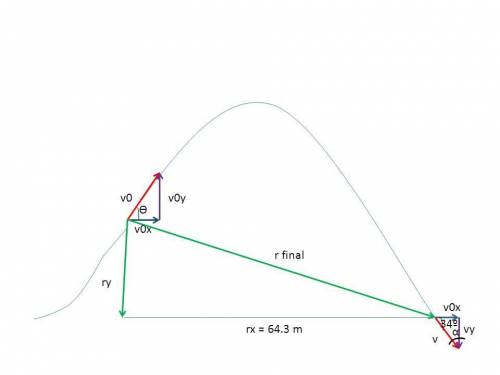
Physics, 18.09.2019 06:00 Mimidj9279
Eddie the eagle, british olympic ski jumper, is attempting his most mediocre jump yet. after leaving the end of the ski ramp, he lands downhill at a point that is displaced 64.3 m horizontally from the edge of the ramp. his velocity just before landing is 29.0 m/s and points in a direction 34.0$^\circ$ below the horizontal. neglect any effects due to air resistance or lift.
a-what was the magnitude of eddie's initial velocity as he left the ramp?
b-determine eddie's initial direction of motion as he left the ramp, measured relative to the horizontal.
c-calculate the height of the ramp's edge relative to where eddie landed.

Answers: 1


Another question on Physics

Physics, 21.06.2019 18:30
Which of these describe conduction transfer of heat between two objects that are touching transfer of heat by the actual movement of war matter the process in which energy is imitated by one of the object transmitted through space and absorbed by another a process in which energy is released by the molecules breaking apart
Answers: 1

Physics, 21.06.2019 23:00
Follow these directions and answer the questions. 1. set up the ripple tank as in previous investigations. 2. bend the rubber tube to form a "concave mirror" and place in the ripple tank. the water level must be below the top of the hose. 3. generate a few straight pulses with the dowel and observe the reflected waves. do the waves focus (come together) upon reflection? can you locate the place where the waves meet? 4. touch the water surface where the waves converged. what happens to the reflected wave? 5. move your finger twice that distance from the hose (2f = c of c, center of the curvature) and touch the water again. does the image (the reflected wave) appear in the same location (c of c)? you may have to experiment before you find the exact location. sometimes it is hard to visualize with the ripple tank because the waves move so quickly. likewise, it is impossible to "see" light waves because they have such small wavelengths and move at the speed of light. however, both are examples of transverse waves and behave in the same way when a parallel wave fronts hit a curved surface.
Answers: 1

Physics, 23.06.2019 01:00
What explosion in the upper solar atmosphere releases about as much energy as millions of 100-megaton hydrogen bombs exploding simultaneously?
Answers: 2

Physics, 23.06.2019 07:30
5. why should the electrons be placed separate from each other (why not together)?
Answers: 2
You know the right answer?
Eddie the eagle, british olympic ski jumper, is attempting his most mediocre jump yet. after leaving...
Questions


Chemistry, 28.11.2019 07:31













Computers and Technology, 28.11.2019 07:31











